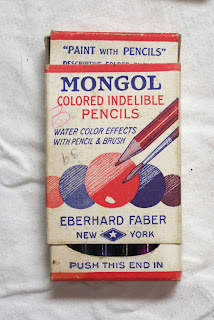Only a few more items remain to be shown. The first is likely the most valuable single item, a book of gold leaf. (And another mention of Hartford, CT)
Some of the leaves have been used but only in small pieces.
There are several unused pages.
I have been looking up information about gilding and finding out that I did not know a lot about it. There are so many different types and applications for gold leaf. When I was thinking that this was Madge's paint box I thought that maybe she was trying something like Klimt did with his use of gold leaf in his oil paintings but it sure did not seem like her style. When I looked up the tole painting I thought that that type of decorative painting would probably have suited Bertha better. I also found reference to sign painter's using gilding for lettering. That would tie in the sign painter's paint. I have been assuming that this was a woman's collection of items, in part because of the reused cosmetic bottles I think.
The final item was another box. It was a box that held Gold leaf but that is not what was in there. I love the graphic design on this box, too bad it got written on.
Here is what was in that box.
A small flat head screw driver, a bit of white chalk, and a few more paper clips....
Two boxes of razor blades....
(Note that Marlin seems to be most proud of their gun line)
A box of crayons from Milton Bradley (another company not far from my home)....
And this box of Mongol water soluble colored pencils. And I had thought that watercolor pencils were a new invention in the last 20 years or so.
A big part of the mystery was solved for me as I pushed the pencils back into their box after inspecting them. I guess there is not doubt now who the artist was.
And under a paper towel lining the bottom of the box I found this ruler and calendar card.
So, we now know that my great aunt Bertha Caswell was the artist and that she was doing some sort of gilding and painting with oils and metal powders. The other day when I was researching a bit more about gilding I found reference to gilders quill brushes. These are made with long hairs and have a natural quill ferrule. They look very similar to the brushes I showed in chapter 2, so the transparent part of the brushes must be quills. They are used for lettering. Maybe even for making letters like these...
...which I noticed on the outside of the box after putting all the contents back. I felt stupid that I did not see them sooner but then there would not have been so much of a mystery. And I would have missed out on a lot of fun trying to piece together the clues and I probably would not have looked at all the items so carefully. So because I was not careful enough in looking at the outside of the box when I found it I was given the opportunity to look deeper at the contents. I think there might be a lesson here.
I still would like to know more about how these things were used so I will do more research and also hope that someone out in internet land might be able to help.
The end.































































